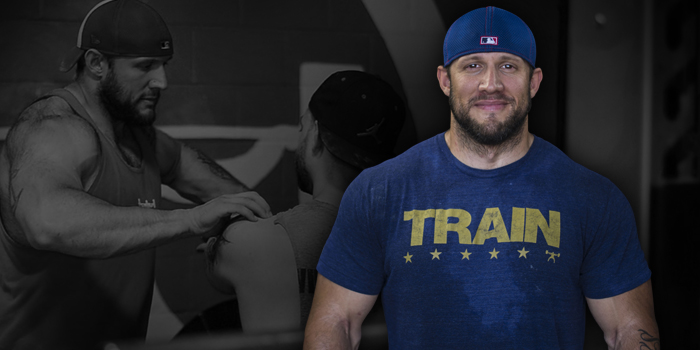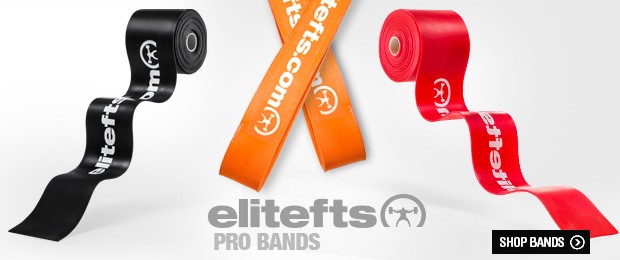
So you’ve purchased some floss tape (also known as compression tape). Or maybe you haven't purchased yet but are looking (in which case I prefer this one, as its elasticity and durability are top notch). In either case, you're probably wondering what the hell to do with it. Sure, you could look up a million different YouTube videos on what to do and come up with some pretty standard stuff, or you could simply read the article below and find three better ways to utilize it.
Let’s start by taking a quick look at what this tool actually is and its original purpose. Then we can dive into some better ways utilize it.
Floss Bands
A floss band is a latex piece of rubber that’s thin, flat, and comes rolled up. It has different elastic strengths depending on which one you get. From elitefts, the red is the least aggressive, the black is second most aggressive, and the blue monster floss band is most aggressive. The purpose and use of this tool is still not yet 100% known. We still aren’t sure how this tool affects the body on a physiological level, but there are some initial positive subjective changes that we (by "we" I mean the people who use it) feel are beneficial and have found repeated positive outcomes. It is important to note that just because something is not scientifically proven, peer reviewed, or academically studied doesn’t mean it doesn’t yield positive results. It's all subject to how it is best used depending on the person. It’s like the fasted versus non-fasted cardio debate.
RECENT: Optimizing Your Pre-Training Routine: The Five Stages of PTR
Using floss bands, it is believed we are making changes to the tissues, joints, fascia, and nerves by adding compression via the floss, integrating movement, and then loading it. Outcomes usually include increased joint range of motion, decreased pain, and increases in blood (oxygen) and nutrient uptake. Lastly, we aim to increase performance and movement quality. Some clinicians and people smarter than me hypothesize that we are increasing fascial shear (gliding of the fascial structures), creating an increase in hypoxia (area of reduced blood and oxygen) followed by the opposite (extreme increase in blood and oxygen) and possibly joint stability through compression and joint mobilization.
Now that we better understand this tool's design and its theoretical purposes, here are three non-traditional ways to better utilize it.
1. Nerve Pain
Pain is a signal that is sent from the brain to the body’s extremities via nerves. Sometimes the nerves can be entrapped, compressed (via tissues or joints), or be under tension by way of poor postural position. Depending on the type of pain—nociceptive pain (tissues) or neuropathic pain (nerves)—the use of this tool can differ. Sometimes tissue pain and nerve pain are intertwined. It’s at that point I like to break out the floss tape and add it to nerve mobilizations. Nerve mobilizations are great for mobilizing—you guessed it—nerves. When nerves become entrapped you might experience numbness, tingling, or even loss of feeling in certain extremities (paresthesia). Of course, there might be additional reasons further up or down stream along the spine that might be contributing. However, that is beyond the scope of this article. Please see a medical professional for assistance and an accurate assessment.
By adding the floss band we get the added benefit of compression. We compress the muscle, tissues, fascia, or joint and slide the nerve in and out to reduce the entrapment, thereby reducing pain. In my opinion, anytime you can add compression and mobilization, you are getting the best of both worlds. In the video below we have self-administered an elitefts floss band to the elbow and performed medial nerve glides.
2. Edema
Edema is an excess of watery fluid that collects in the tissues, joints, or extremities. The reasons for edema can vary: too much prolonged inflammation, acute injuries, tissue damage, etc. The most common treatments include, ice, elevation, compression, or a combination of each. As rehab has evolved, we now know that ice isn’t the best and that compression and movement are. However, sometimes the ability to move a joint is limited, depending on the acuteness of the injury. I believe that despite the acuteness of an injury, there is a use of the floss band.
With the technique above we have added the floss band but are creating isometric contractions of the muscles that attach to the joint. In the video below the knee is swollen. We have added a floss band and are creating isometric contractions to the quadriceps, hamstrings, gastrocnemius, and the tibialis anterior. There are of course other contributing muscles, but these are the largest in the lower leg. By creating the isometric contractions we better push lymph in and out of the affected joint, creating less tension and better range of motion. The key is continuously repositioning the knee at different angles to create a variability of the isometric contraction. Because this might be an acute injury, we may have limited active range of motion, so by repositioning the joint into pain-free positions and then adding the isometrics, we are essentially creating a movement and compression environment.
3. Rehab
In my clinic, we use floss bands in the traditional sense: compression and mobilization. We use it to increase the range of motion of an affected joint and to increase the sliding properties of tissues, fascia, and nerves. However, when dealing with tendon and ligament injuries, I use the floss band in an unorthodox way.
First, we need to talk about gearing. During a muscle contraction, the muscles fibers may shorten at a rate different from the muscular-tendon structure. The ratio of these velocities is its gearing. A high ratio means the muscle pulls away from the tendon too fast and may cause further injury. This often happens when people get strong very quickly while rehabbing an injury. As a practitioner and someone like yourself who might be rehabbing a tendon issue, this is not good. We want to slow this down. Adding external compressive forces reduces muscle thickness by spreading (smashing) the muscle tissue fibers. This effectively reduces the gearing ratio and doesn’t allow the muscle to contract too hard, too fast despite muscular contractions. This is important when increasing tissue capacity and creating an environment for a muscle to contract and transfer load. This is best used in the beginning stages of rehab when first adding load and tension to a muscle.
In the video above, we have an example of using a gastrocnemius (calves) injury. We have compressed the gastrocnemius almost in its entirety and are again using various muscular contractions with and without load, movement, and compression. I recommend first using isometric contraction, progressing to eccentric contractions, and then finally to full muscular contractions. Depending on the severity of the injured tissues this can take weeks or months to progress.
Whatever you want to call this tool (compression tape, floss band, voodoo bands, etc.), it can be very useful. In this article I talked about using it to reduce nerve pain stemming from nociceptive or neuropathic pain, reducing edema via compression and isometric contractions, and an unorthodox approach to rehabbing tendon injuries by reducing muscle fiber contraction strength and rate (gearing). Add these three techniques to your training or rehab programming for better, faster, safer progress. If you have any questions please feel free to contact me at JasonColley@prsystemstherapy.com or visit www.PRsystemstherapy.com to schedule an assessment and treatment.











1 Comment